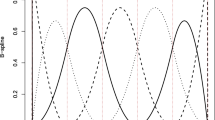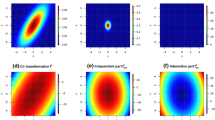Abstract
We construct by using B-spline functions a class of copulas that includes the Bernstein copulas arising in Baker’s distributions. The range of correlation of the B-spline copulas is examined, and the Fréchet–Hoeffding upper bound is proved to be attained when the number of B-spline functions goes to infinity. As the B-spline functions are well-known to be an order-complete weak Tchebycheff system from which the property of total positivity of any order follows for the maximum correlation case, the results given here extend classical results for the Bernstein copulas. In addition, we derive in terms of the Stirling numbers of the second kind an explicit formula for the moments of the related B-spline functions on the right half-line.
Similar content being viewed by others
References
Baker, R. (2008). An order-statistics-based method for constructing multivariate distributions with fixed marginals. J. Multivar. Anal. 99, 2312–2327.
Block, H.W. and Sampson, A.R. (2006). Inequalities on distributions: Bivariate and multivariate. In Encyclopedia of Statistical Sciences, Volume 5, 2nd edn. Wiley, Hoboken, Balakrishnan, N. et al. (eds.), p. 3453–3459.
Branson, D. (2000). Stirling numbers and Bell numbers: Their role in combinatorics and probability. Math. Scientist 25, 1–31.
Carlitz, L. (1960). Note on Nörlund’s Polynomial \(B_{n}^{(z)}\). Proc. Am. Math. Soc. 11, 452–455.
de Boor, C. (1972). On calculating with B-splines. J. Approx. Theory 6, 50–62.
de Boor, C. (1976). Total positivity of the spline collocation matrix. Indiana Univ. Math. J. 25, 541–551.
de Boor, C.A. (2001). A Practical Guide to Splines, Revised edn. Springer, New York.
Dou, X., Kuriki, S. and Lin, G.D. (2013). Dependence structures and asymptotic properties of Baker’s distributions with fixed marginals. J. Stat. Plan. Inference 143, 1343–1354.
Dou, X., Kuriki, S., Lin, G.D. and Richards, D. (2014). EM algorithms for estimating the Bernstein copula. Comput. Stat. Data Anal. 93, 228–245.
Gross, K.I. and Richards, D.St.P. (1998). Algebraic methods toward higher order probability inequalities. In Stochastic Processes and Related Topics. Birkhäuser, Boston, Rajput, B. et al. (eds.), p. 189–211.
Hardy, G.H., Littlewood, J.E. and Pólya, G. (1929). Some simple inequalities satisfied by convex functions. Messenger Math. 58, 145–152.
Huang, J.S., Dou, X., Kuriki, S. and Lin, G.D. (2013). Dependence structure of bivariate order statistics with applications to Bayramoglu’s distributions. J. Multivar. Anal. 114, 201–208.
Hwang, J.S. and Lin, G.D. (1984). Characterizations of distributions by linear combinations of moments of order statistics. Bull. Instit. Math. Academia Sinica 12, 179–202.
Karlin, S. (1968). Total Positivity, 1. Stanford University Press, Palo Alto.
Karlin, S. and Studden, W.J. (1966). Tchebycheff Systems: With Applications in Analysis and Statistics. Wiley, New York.
Lin, G.D. and Huang, J.S. (2010). A note on the maximum correlation for Baker’s bivariate distributions with fixed marginals. J. Multivar. Anal. 101, 2227–2233.
Lin, G.D., Dou, X., Kuriki, S. and Huang, J.S. (2014). Recent developments on the construction of bivariate distributions with fixed marginals. J. Statist. Distrib. Appl.1, 14.
Lin, G.D., Dou, X. and Kuriki, S. (2018). The bivariate lack-of-memory distributions. To appear in Sankhyā Ser. A. Available at https://doi.org/10.1007/s13171-017-0119-1.
Macdonald, I.G. (2015). Symmetric Functions and Hall Polynomials, 2nd edn. Oxford University Press, New York.
Marshall, A.W., Olkin, I. and Arnold, B.C. (2011). Inequalities: Theory of Majorization and Its Applications, 2nd edn. Springer, New York.
Neuman, E. (1981). Moments and Fourier transforms of B-splines. J. Comput. Appl. Math. 7, 51–62.
Nürnberger, G. (1989). Approximation by Spline Functions. Springer, New York.
Pinkus, A. (2010). Totally Positive Matrices. Cambridge University Press, New York.
Schumaker, L.L. (2007). Spline Functions Basic Theory, 3rd edn. Cambridge University Press, Cambridge.
Sklar, A. (1959). Fonctions de répartition à n dimensions et leurs marges. Publications de l’Institut de Statistique de L’Université de Paris 8, 229–231.
Shen, X., Zhu, Y. and Song, L. (2008). Linear B-spline copulas with applications to nonparametric estimation of copulas. Comput. Stat. Data Anal. 52, 3806–3819.
Wagner, C.G. (1996). Generalized Stirling and Lah numbers. Discret. Math. 160, 199–218.
Acknowledgments
The authors thank the Editor and the referees for their helpful comments that lead to the improvement of the paper. This work was supported by JSPS KAKENHI Grants, Numbers 16K00060 and 16H02792.
Author information
Authors and Affiliations
Corresponding author
Additional information
Publisher’s Note
Springer Nature remains neutral with regard to jurisdictional claims in published maps and institutional affiliations.
This work was supported by JSPS KAKENHI Grants, Numbers 16K00060 and 16H02792.
Appendix
Appendix
Proof of Theorem 8.
We prove the statement by mathematical induction on d. Note first that (5.7) with d = 0 coincides with the boundary conditions (5.4) for all i and h.
Suppose that (5.7) is true for the case d − 1 and for all i and h, then we wish to prove that it also holds true for the case d and for all i and h.
-
(i)
For i ≥ 0, by the assumption of induction,
$$ \gamma^{d-1}_{i}(h) = \sum\limits_{\ell=0}^{h} i^{\ell} \binom{h}{\ell} \frac{S(h+d-\ell,d)}{\displaystyle\binom{h+d-\ell}{d}}. $$Then, we have
$$ \gamma^{d-1}_{i+1}(h) = \sum\limits_{k=0}^{h} (i+1)^{k} \binom{h}{k} \frac{S(h+d-k,d)}{\displaystyle\binom{h+d-k}{d}}, $$and by expanding (i + 1)k using the binomial theorem, we obtain
$$ \gamma^{d-1}_{i+1}(h) = \sum\limits_{k=0}^{h} \sum\limits_{\ell=0}^{k} i^{\ell} \binom{k}{\ell} \binom{h}{k} \frac{S(h+d-k,d)}{\displaystyle\binom{h+d-k}{d}}. $$Interchanging the order of summation and using the identity,
$$ \binom{k}{\ell} \binom{h}{k} = \binom{h}{\ell} \binom{h-\ell}{k-\ell}, $$we find that
$$ \gamma^{d-1}_{i+1}(h) = \sum\limits_{\ell=0}^{h} i^{\ell} \binom{h}{\ell} \sum\limits_{k=\ell}^{h} \binom{h-\ell}{k-\ell} \frac{S(h+d-k,d)}{\displaystyle\binom{h+d-k}{d}}. $$Replacing k by k − ℓ, we have
$$ \gamma^{d-1}_{i+1}(h) = \sum\limits_{\ell=0}^{h} i^{\ell} \binom{h}{\ell} \sum\limits_{k=0}^{h-\ell} \binom{h-\ell}{k} \frac{S(h+d-\ell-k,d)}{\displaystyle\binom{h+d-\ell-k}{d}}, $$and using the identity,
$$ \frac{\displaystyle\binom{h-\ell}{k}}{\displaystyle\binom{h+d-\ell-k}{d}} = \frac{\displaystyle\binom{h+d-\ell}{h+d-\ell-k}}{\displaystyle\binom{h+d-\ell}{d}}, $$we deduce that
$$ \begin{array}{@{}rcl@{}} \gamma^{d-1}_{i+1}(h) &=& \sum\limits_{\ell=0}^{h} i^{\ell} \binom{h}{\ell} \frac{1}{\displaystyle\binom{h+d-\ell}{d}} \sum\limits_{k=0}^{h-\ell} \binom{h+d-\ell}{h+d-\ell-k}\\ &&\times S(h+d-\ell-k,d) \\ &= &\sum\limits_{\ell=0}^{h} i^{\ell} \binom{h}{\ell} \frac{S(h+d-\ell+1,d+1)}{\displaystyle\binom{h+d-\ell}{d}}, \end{array} $$(6.1)where the last equality follows from the identity (5.6). Moreover, using the identity,
$$ \binom{h+1}{\ell} = \binom{h}{\ell-1} + \binom{h}{\ell}, $$we obtain
$$ \begin{array}{@{}rcl@{}} &&\gamma^{d-1}_{i}(h + 1) - i \gamma^{d-1}_{i}(h) \\ &&\qquad= i^{h+1} + \sum\limits_{\ell=0}^{h} \left[ i^{\ell} \binom{h+1}{\ell} \frac{S(h+d-\ell+1,d)}{\displaystyle\binom{h+d-\ell+1}{d}} \right.\\ && \qquad\qquad\qquad\qquad \left.- i^{\ell+1} \binom{h}{\ell} \frac{S(h+d-\ell,d)}{\displaystyle\binom{h+d-\ell}{d}} \right] \\ &&\qquad= i^{h+1} + \sum\limits_{\ell=0}^{h} \left[ i^{\ell} \left\{ \binom{h}{\ell-1} + \binom{h}{\ell} \right\} \frac{S(h+d-\ell+1,d)}{\displaystyle\binom{h+d-\ell+1}{d}} \right.\\ && \qquad\qquad\qquad\qquad \left.- i^{\ell+1} \binom{h}{\ell} \frac{S(h+d-\ell,d)}{\displaystyle\binom{h+d-\ell}{d}} \right]. \end{array} $$(6.2)Since S(d, d) = 1 then
$$ \begin{array}{@{}rcl@{}} i^{h+1} + \sum\limits_{\ell=0}^{h} i^{\ell} \binom{h}{\ell-1}\frac{S(h+d-\ell+1,d)} {\displaystyle\binom{h+d-\ell+1}{d}} &= &\sum\limits_{\ell=1}^{h+1} i^{\ell} \binom{h}{\ell-1}\frac{S(h+d-\ell+1,d)} {\displaystyle\binom{h+d-\ell+1}{d}} \\ &=& \sum\limits_{\ell=0}^{h} i^{\ell} \binom{h}{\ell}\frac{S(h+d-\ell,d)} {\displaystyle\binom{h+d-\ell}{d}}, \end{array} $$and substituting this result into (6.2), we obtain
$$ \gamma^{d-1}_{i}(h+1)-i \gamma^{d-1}_{i}(h) = \sum\limits_{\ell=0}^{h} i^{\ell} \binom{h}{\ell} \frac{S(h+d-\ell+1,d)}{\displaystyle\binom{h+d-\ell+1}{d}}. $$(6.3)Similarly, it follows from Eq. (6.1) that
$$ \begin{array}{@{}rcl@{}} &&\gamma^{d-1}_{i+1}(h+1)-i\gamma^{d-1}_{i+1}(h) {\kern12pc}\\ &&\qquad= i^{h+1} + \sum\limits_{\ell=0}^{h} \left[ i^{\ell} \binom{h+1}{\ell} \frac{S(h+d-\ell+2,d+1)}{\displaystyle\binom{h+d-\ell+1}{d}} \right. \\ && \qquad\qquad\qquad\qquad \left.- i^{\ell+1} \binom{h}{\ell} \frac{S(h+d-\ell+1,d+1)}{\displaystyle\binom{h+d-\ell}{d}} \right]{\kern4pc}\\ &&\qquad= \sum\limits_{\ell=0}^{h} i^{\ell} \binom{h}{\ell} \frac{S(h+d-\ell+2,d+1)}{\displaystyle\binom{h+d-\ell+1}{d}}. \end{array} $$(6.4)Hence, by substituting (6.3) and (6.4) into (5.3), we find that
$$ \begin{array}{@{}rcl@{}} {\gamma^{d}_{i}}(h) &=& \frac{\gamma^{d-1}_{i}(h+1)-i \gamma^{d-1}_{i}(h)}{d} -\frac{\gamma^{d-1}_{i+1}(h+1)-i\gamma^{d-1}_{i+1}(h)}{d} +\frac{d+1}{d}\gamma^{d-1}_{i+1}(h) \\ &=& \sum\limits_{\ell=0}^{h} i^{\ell} \binom{h}{\ell} \left[ \frac{S(h+d-\ell+1,d)}{d \displaystyle\binom{h+d-\ell+1}{d}} - \frac{S(h+d-\ell+2,d+1)}{d \displaystyle\binom{h+d-\ell+1}{d}} \right.\\ && \qquad\qquad\qquad\qquad\qquad\qquad \left.+ \frac{(d+1)S(h+d-\ell+1,d+1)}{d \displaystyle\binom{h+d-\ell}{d}} \right] \\ &=& \sum\limits_{\ell=0}^{h} i^{\ell} \binom{h}{\ell} \frac{S(h+d-\ell+1,d+1)}{\displaystyle\binom{h+d-\ell+1}{d+1}}, \end{array} $$where the last equality follows from the recurrence formula (5.5).
-
(ii)
When − d < i < 0, by the assumption of induction,
$$ \gamma^{d-1}_{i}(h) = \frac{i+d}{d} \cdot \frac{S(h+i+d,i+d)}{\displaystyle\binom{h+d}{d}}. $$It then follows from Eq. (5.3) that
$$ \begin{array}{@{}rcl@{}} {\gamma^{d}_{i}}(h) &=& \frac{\gamma^{d-1}_{i}(h+1)}{i+d} + \frac{(i+d+1)\gamma^{d-1}_{i+1}(h) -\gamma^{d-1}_{i+1}(h+1)}{i+d+1} \\ &=& \frac{1}{i+d} \frac{i+d}{d} \frac{S(h+i+d+1,i+d)}{\displaystyle\binom{h+d+1}{d}} \\ &&\qquad + \frac{i+d+1}{d} \frac{S(h+i+d+1,i+d+1)}{\displaystyle\binom{h+d}{d}} \\ &&\qquad -\frac{1}{i+d+1} \frac{i+d+1}{d} \frac{S(h+i+d+2,i+d+1)}{\displaystyle\binom{h+d+1}{d}} \\ &=& \frac{i+d+1}{d+1} \frac{S(h+i+d+1,i+d+1)}{\displaystyle\binom{h+d+1}{d+1}}. \end{array} $$Here we used the recurrence formula (5.5) with n = h + i + d + 1 and k = i + d + 1, viz.,
$$ \begin{array}{@{}rcl@{}} S(h+i+d+2,i+d+1) &=& (i+d+1)S(h+i+d+1,i+d+1)\\ &&+ S(h+i+d+1,i+d). \end{array} $$ -
(iii)
When i = −d, by the inductive hypothesis,
$$ \gamma^{d-1}_{-d+1}(h) = \frac{h! (d-1)!}{(h+d)!}. $$Then, by Eq. (5.3), we have
$$ \begin{array}{@{}rcl@{}} \gamma^{d}_{-d}(h) &=& \gamma^{d-1}_{-d+1}(h) -\gamma^{d-1}_{-d+1}(h+1) = \frac{h! d!}{(h+d+1)!}, \end{array} $$(6.5)which coincides with Eq. (5.7) with i = −d.
The proof is completed by induction on d. □
Rights and permissions
About this article
Cite this article
Dou, X., Kuriki, S., Lin, G.D. et al. Dependence Properties of B-Spline Copulas. Sankhya A 83, 283–311 (2021). https://doi.org/10.1007/s13171-019-00179-y
Received:
Published:
Issue Date:
DOI: https://doi.org/10.1007/s13171-019-00179-y
Keywords and phrases
- Bernstein copula
- Fréchet–Hoeffding upper bound
- Order-complete weak Tchebycheff system
- Schur function
- Stirling number of the second kind
- Total positivity of order r.




